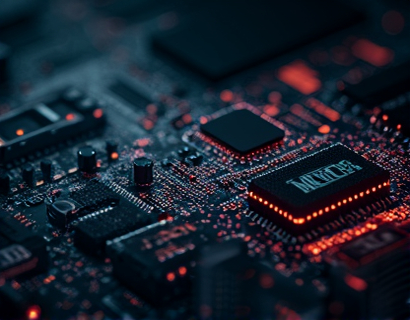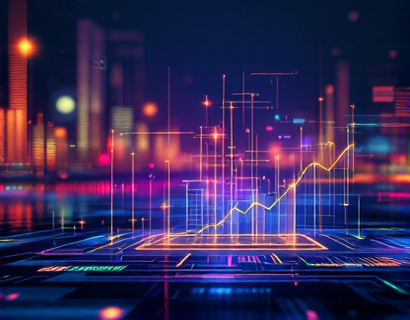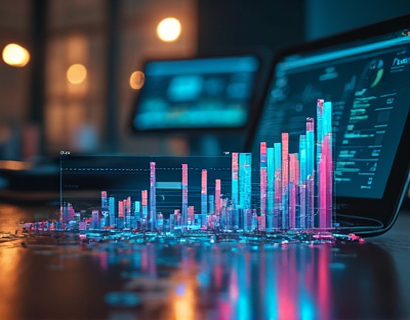Next-Gen Smart Contract AMMs: Revolutionizing DeFi Trading with Advanced Automation and Liquidity Management
The decentralized finance (DeFi) ecosystem has witnessed exponential growth, driven by innovative technologies and smart contract applications. Among these advancements, Automated Market Makers (AMMs) have emerged as a pivotal component, offering a decentralized alternative to traditional order books. Next-generation smart contract AMMs are redefining the landscape of DeFi trading by integrating advanced automation and sophisticated liquidity management. This article delves into the intricacies of these cutting-edge AMMs, exploring how they optimize trading experiences for crypto traders and DeFi enthusiasts.
Understanding Automated Market Makers
Traditional AMMs rely on predefined algorithms to determine asset prices based on the ratio of tokens in liquidity pools. However, next-gen AMMs take this a step further by incorporating machine learning, predictive analytics, and real-time market data to dynamically adjust pricing and liquidity provision. These enhancements ensure that the AMM remains responsive to market conditions, minimizing slippage and improving trade execution.
One of the core principles of next-gen AMMs is their ability to automate trading strategies. By leveraging smart contracts, these platforms can execute trades based on predefined criteria, such as price thresholds, volatility levels, and market trends. This automation not only reduces the need for manual intervention but also enhances the efficiency and consistency of trading operations.
Advanced Liquidity Management
Liquidity management is a critical aspect of DeFi trading, and next-gen AMMs have introduced innovative solutions to address the challenges associated with traditional liquidity pools. One significant advancement is the implementation of dynamic liquidity provision, which adjusts the amount of liquidity based on real-time market demand and supply. This adaptive approach ensures that liquidity is always optimized, reducing the risk of impermanent loss and improving overall portfolio performance.
Another key feature is the introduction of liquidity incentives that are more sophisticated and tailored to individual trader needs. Instead of generic token rewards, next-gen AMMs offer customized incentive structures that reward users based on their trading activity, liquidity provision duration, and market impact. This personalized approach encourages long-term engagement and fosters a more robust and resilient liquidity ecosystem.
Enhanced User Experience through Automation
The automation capabilities of next-gen AMMs significantly enhance the user experience. Traders can set up automated trading bots that execute trades 24/7, without the need for constant monitoring. These bots can be programmed to follow complex strategies, such as arbitrage, mean reversion, and momentum trading, all while adhering to predefined risk parameters. This level of automation not only saves time but also reduces the potential for human error.
Furthermore, the integration of user-friendly interfaces and intuitive dashboards allows traders to easily manage their liquidity positions and trading strategies. Real-time analytics and insights provide a comprehensive overview of market conditions and trade performance, enabling informed decision-making. The seamless integration of these tools ensures that users can focus on strategic planning rather than day-to-day operations.
Security and Trust in DeFi AMMs
Security remains a paramount concern in the DeFi space, and next-gen AMMs have taken significant steps to enhance trust and protect user assets. Smart contract audits conducted by reputable firms ensure that the code is free from vulnerabilities and exploits. Additionally, the use of multi-signature wallets and decentralized governance models empowers the community to participate in decision-making processes, further bolstering the security and transparency of the platform.
Transparency is another cornerstone of these advanced AMMs. All transactions, liquidity provision details, and trading activities are recorded on the blockchain, providing an immutable and verifiable record. This level of transparency not only builds trust among users but also facilitates audits and compliance with regulatory requirements.
Optimizing Market Efficiency
Next-gen AMMs contribute to the overall efficiency of the DeFi market by reducing friction and improving liquidity. The dynamic pricing models and real-time data integration ensure that asset prices are more accurately reflected, minimizing price discrepancies across different platforms. This alignment enhances market efficiency and promotes fair trading practices.
Moreover, the ability to handle a wider range of assets, including complex tokens and derivatives, expands the scope of tradable instruments in the DeFi ecosystem. This diversification attracts a broader user base and fosters innovation, as developers can build new financial products and services on top of these advanced AMMs.
Case Studies and Real-World Applications
Several projects have successfully implemented next-gen AMM technologies, demonstrating their practical benefits. For instance, a particular platform has seen a significant increase in liquidity and trade volume since adopting a dynamic liquidity provision system. Traders report lower slippage and higher trade execution speeds, leading to improved portfolio performance.
Another example showcases the use of automated trading bots in executing sophisticated arbitrage strategies across multiple DeFi protocols. These bots have consistently generated substantial returns while maintaining a low risk profile, highlighting the potential of automation in enhancing trading strategies.
Future Prospects and Challenges
The future of next-gen smart contract AMMs looks promising, with ongoing research and development aimed at addressing current challenges and unlocking new possibilities. One area of focus is the integration of off-chain solutions to handle high-volume transactions more efficiently, reducing gas fees and improving scalability. Additionally, the development of cross-chain AMMs will enable seamless trading across different blockchain ecosystems, further expanding the reach and utility of these platforms.
However, challenges remain, such as ensuring regulatory compliance and addressing the technical complexity of advanced features. Educating users about the benefits and risks associated with these sophisticated AMMs is crucial for widespread adoption. As the ecosystem matures, collaboration between developers, regulators, and users will be essential in shaping a robust and inclusive DeFi landscape.
In conclusion, next-gen smart contract AMMs are revolutionizing DeFi trading by offering advanced automation, optimized liquidity management, and enhanced user experiences. These innovations not only improve the efficiency and security of trading operations but also pave the way for new financial opportunities in the decentralized world. As the technology continues to evolve, it is poised to play a pivotal role in the future of finance.











































